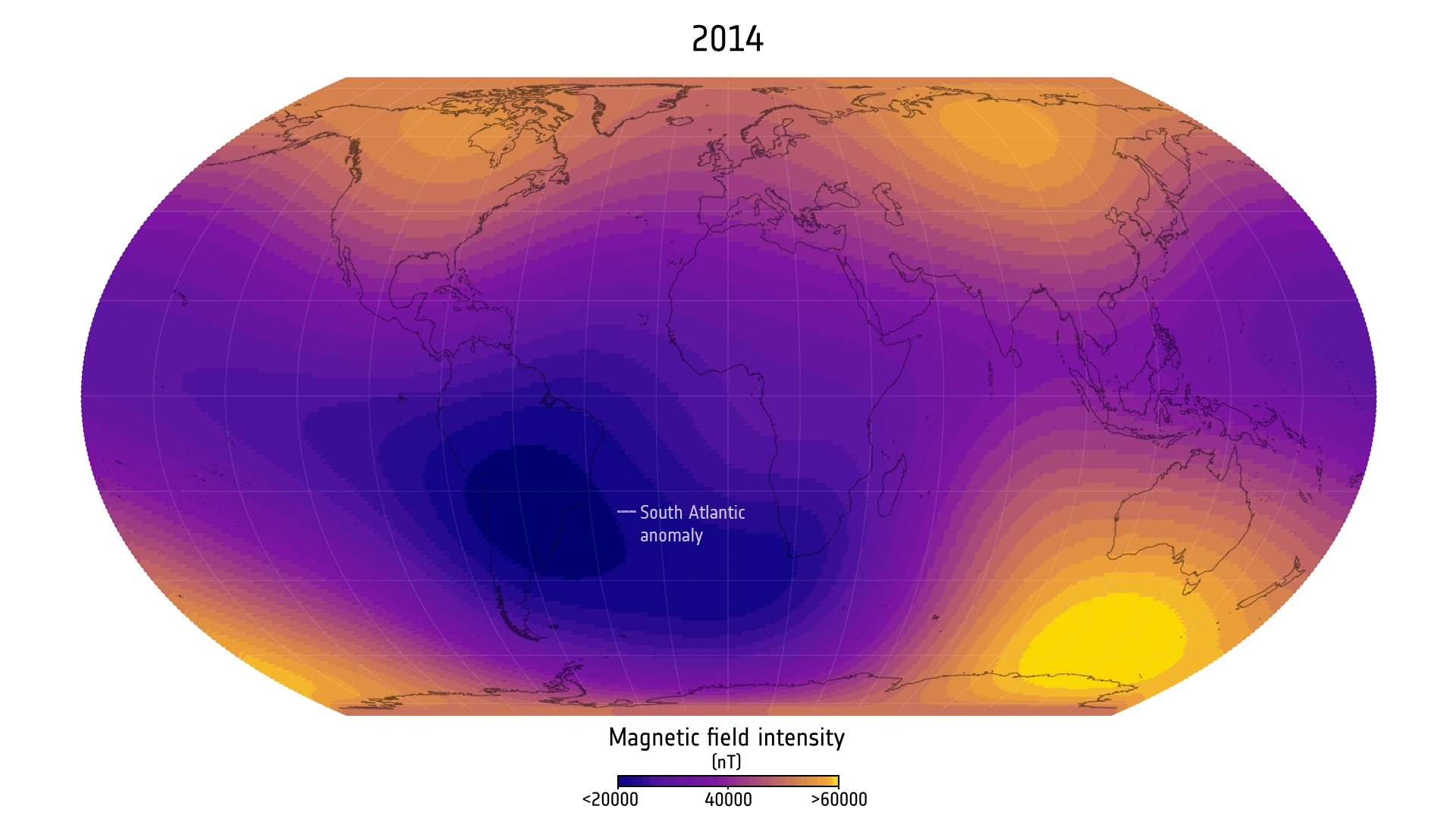The Earth’s magnetic field has a giant weak spot roughly aligned with the south Atlantic, and 11 years of observations show it has grown dramatically in that time. The cause of the South Atlantic Anomaly (SAA) is still debated, but the changes show it is dynamic on a relatively short timescale, considering evidence it has persisted on geological timescales.
Without the Earth’s magnetic field, life would be unlikely here – at least, anything more complex than bacteria. The field shields the planet from bombardment by charged particles, and therefore helps maintain our atmosphere. So, it’s a little alarming that the gaps in our knowledge about it – including why it varies so much over the planet – could fill half an ocean.
In an effort to address this ignorance, the European Space Agency developed Swarm, a set of three satellites that measure magnetism across different parts of the Earth. One of the chief outcomes has been detailed observations of the SAA, whose presence has been known since the 19th century, but which was initially mapped too intermittently to keep track of changes.
A new study shows that not only has the SAA been growing in both expanse and the extremity of its weakness since 2014, but the pace has accelerated since 2014. That’s odd for something we have been tracking, albeit in less detail, for almost two centuries, but it’s even stranger now evidence is emerging that the SAA is vastly older, probably dating back millions of years.

A comparison of the size and shape of the South Atlantic Anomaly in 2014 and today.
Image credit: European Space Agency
“The South Atlantic Anomaly is not just a single block,” Professor Chris Finlay of the Technical University of Denmark said in statement. “It’s changing differently towards Africa than it is near South America. There’s something special happening in this region that is causing the field to weaken in a more intense way.”
The SAA has no sharp boundaries, but if it is defined to represent the places where the Earth’s magnetic field is less than 26,000 nanoteslas (nT), it now covers almost 1 percent more of the Earth’s surface than in 2014. That’s an area half as large as the United States. The weakest region is now 22,094 nT, down from 22,430 nT in 2014.
“Normally we’d expect to see magnetic field lines coming out of the core in the southern hemisphere,” Finlay added. “But beneath the South Atlantic Anomaly we see unexpected areas where the magnetic field, instead of coming out of the core, goes back into the core. Thanks to the Swarm data we can see one of these areas moving westward over Africa, which contributes to the weakening of the South Atlantic Anomaly in this region.”
Despite fears the Earth’s magnetic field is about to switch directions, possibly temporarily disappearing in the process, the SAA is not indicative of the state of the entire field. Instead, the Swarm data reveals three places where the field is unusually strong; in Canada and Siberia, and between Australia and Antarctica.
The Siberian anomaly has grown to cover an extra 0.42 percent of the planet since Swarm’s observations started, and now has peak strength of 61,619 nT, more than double the SAA, but the Canadian area of overstrength has shrunk.
“When you’re trying to understand Earth’s magnetic field, it’s important to remember that it’s not just a simple dipole, like a bar magnet. It’s only by having satellites like Swarm that we can fully map this structure and see it changing,” Finlay said.
To understand the reasons for the SAA’s growing size and intensity, we would need to know why it exists in the first place. Although Finlay and co-authors attribute the weakness to processes within the core, the paper is primarily about documenting, rather than explaining the changes. In particular, the question of how the SAA relates to the Large Low Seismic Velocity Province (LLSVP) that sits at the core/mantle boundary in the same area, remains unanswered.
The weakness of the SAA poses little threat on the ground, but it means satellites are more exposed to radiation when they pass overhead, which can trigger both immediate failures and contribute to long-term cumulative damage. However, that damage is probably less important than what the SAA can tell us about the nature and evolution of the magnetic field. If, as we suspect, a strong magnetic field is essential for habitability elsewhere, that information could be precious.
Although Swarm was originally deployed for a short mission, it has outlasted expectations. Despite regular exposure to increased radiation as the satellites pass over the SAA, all three are in good shape and its operators hope it will provide plenty more data.
The study is published open access in Physics of the Earth and Planetary Interiors.
Source Link: The South Atlantic’s Giant Weak Spot In The Earth’s Magnetic Field Is Growing